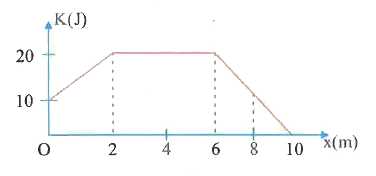The force acting on a particle moving along X-axis is F=−k(x−v0t) where k is a positive constant. An observer moving at a constant velocity v0 along the X-axis looks the particle . What kind of motion does he find for the particle?Solution in Tamil
Step by step video & image solution for The force acting on a particle moving along X-axis is F=-k(x-v_0t) where k is a positive constant. An observer moving at a constant velocity v_0 along the X-axis looks the particle . What kind of motion does he find for the particle? by Physics experts to help you in doubts & scoring excellent marks in Class 11 exams.
Updated on:21/07/2023Topper's Solved these Questions
- SIMPLE HARMONIC MOTIONBOOK - HC VERMACHAPTER - SIMPLE HARMONIC MOTIONEXERCISE - Objective -1
21 Videos
- SIMPLE HARMONIC MOTIONBOOK - HC VERMACHAPTER - SIMPLE HARMONIC MOTIONEXERCISE - Objective-2
16 Videos
- SIMPLE HARMONIC MOTIONBOOK - HC VERMACHAPTER - SIMPLE HARMONIC MOTIONEXERCISE - worked out Examples
22 Videos
- ROTATIONAL MECHANICSBOOK - HC VERMACHAPTER - ROTATIONAL MECHANICSEXERCISE - Exercises
86 Videos
- SOME MECHANICAL PROPERTIES OF MATTERBOOK - HC VERMACHAPTER - SOME MECHANICAL PROPERTIES OF MATTEREXERCISE - Exercises
32 Videos
Similar Questions
A student says that he had applied a force F=−k√x on a particle and the particle moved in simple harmonic motion. He refuses to tell whether k is a constant or not. Assume that he has worked only with positive x and no other force acted on the particle
View SolutionSelect the correct statements
View SolutionThe equation of a particle executing simple harmonic motion is x=(5m)sin[(πs−1)t+π3]. Write down the amplitude time period and maximum speed. Also find the velocity at t=1s.
View SolutionA wheel is making revolutions about its axis with uniform angular acceleration. Starting from rest, till it reaches 100 rev/sec in 4 seconds. Find the angular acceleration.
View SolutionA load of 10 kg is suspended by a metal wire 3 m long and having a cross sectional area 4mm2. Find a. the stress b. the strain and c. the elongation. Young modulus of the metal is2.0×1011Nm−2
View SolutionA force F = -K(y hatI + x hatj) (where K is a posive constant ) acts on a particle moving in the xy plane . Starting form the original , the partical is taken along in the positive x axis to the point (x,0) and then partical to they axis the point (x,0) . The total work done by the force F on the particls is
View SolutionA force F=-K(yhati+xhatj) (where K is a positive constant) acts on a particle moving in the x-y plane. Starting from the origin, the particle is taken along the positive x-axis to the point (a, 0) , and then parallel to the y-axis to the point (a, a) . The total work done by the force F on the particle is
View SolutionA particle moving along the X-axis executes simple harmonic motion, then the force acting on it is given by
where, A and K are positive constants.
View SolutionA particle moves along x-axis with acceleration a=6(t-1) where t is in second. If the particle is initially at the origin and it moves along positive x-axis with v_(0)=2m//s , find the nature of motion of the particle.
View SolutionA force F=−K(yˆi+xˆj) (where K is a positive constant) acts on a particle moving in the x-y plane. Starting from the origin, the particle is taken along the positive x-axis to the point (a,0), and then parallel to the y-axis to the point (a,a). The total work done by the force F on the particle is
View SolutionSTATEMENT -1 : The force acting on a particle moving alongx -axis is F = - alpha ( x+ vt) , where alpha is a constant. and STATEMENT-2 : To anobserver moving along x-axis with constant velocity v, it represents SHM.
View SolutionA force F=−K(yˆi+xˆj) (where K is a positive constant) acts on a particle moving in the x-y plane. Starting from the origin, the particle is taken along the positive x-axis to the point (a,0), and then parallel to the y-axis to the point (a,a). The total work done by the force F on the particle is
View SolutionA particle moving along the x axis is acted upon by a single force F = F_0 e^(-kx) , where F_0 and k are constants. The particle is released from rest at x = 0. It will attain a maximum kinetic energy of :
View SolutionThe kinetic energy K of a particle moving along x - axis varies its position (x) as shown in figure.

The magnitude of force acting on particle at x = 9m is
View SolutionA particle, moving along the x-axis, executes simple harmonic motion when the force acting on it is given by (A and k are positive constant.)………………
View Solutionm द्रव्यमान का एक कण नियत बल के अंतर्गत X - अक्ष के अनुदिश गतिशील है। कण के वेग तथा स्थिति के समीकरण व्यत्पन्न करो।
View Solution
